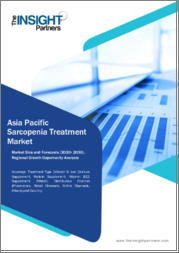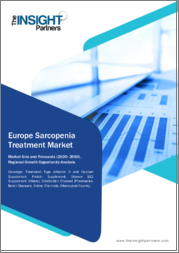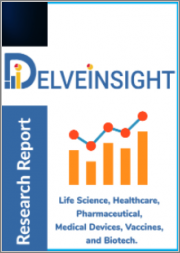
|
시장보고서
상품코드
1856055
사르코페니아 시장 - 세계 및 지역별 분석 : 치료 클래스, 투여 경로, 유통 채널, 지역별 분석과 예측(2025-2035년)Sarcopenia Market - A Global and Regional Analysis: Focus on Treatment Class, Route of Administration, Distribution Channel, and Region - Analysis and Forecast, 2025-2035 |
||||||
고령 인구의 급속한 증가로 인해 근위축성 질환의 전 세계 유병률이 크게 증가하고 있으며, 이는 세계 근감소증 시장의 성장을 주도하고 있습니다. 특히 선진국과 신흥 국가에서 60세 이상 노인 인구가 지속적으로 증가함에 따라 근육감소증 진단과 치료에 대한 수요가 빠르게 증가하고 있습니다. 또한 악력 평가, 보행 속도 검사, DXA(이중 에너지 X선 흡수 측정법) 등의 진단 툴의 발전으로 근감소증을 조기에 발견할 수 있는 능력이 향상되고 있습니다.
이러한 임상적 인식 증가로 인해 근육감소증은 더 자주 발견되어 적시에 개입할 수 있게 되었습니다. 또한 특히 테스토스테론 보충과 같은 호르몬 치료와 미오스타틴 억제제 및 선택적 안드로겐 수용체 조절제(SARM)와 같은 근육 동화 경로를 표적으로 하는 생물제제 개발에서 치료제의 혁신이 활발히 진행되고 있습니다. 이러한 발전은 노인 인구의 근육감소증을 보다 효과적이고 효과적으로 관리할 수 있는 유망 수단을 제공합니다.
시장 성장을 저해하는 주요 과제 중 하나는 국제적으로 통일된 진단 기준의 부재입니다. EWGSOP, AWGS 및 기타 지역 단체에서 제시하는 다양한 진단 기준은 근육감소증의 식별 및 분류에 일관성이 부족하여 대규모 임상 연구, 규제 당국의 승인 및 치료 표준화를 방해하고 있습니다. 또한 근육감소증 관련 치료, 특히 영양 보충제 및 비약물 요법에 대한 보험 적용 및 상환이 제한되어 있으며, 환자의 접근성이 제한되고, 의료 프로바이더의 치료법 채택 의욕이 저하되고 있습니다.
세계 근육감소증 시장은 새로운 헬스케어 동향과 기술 발전에 힘입어 큰 기회를 제공합니다. 급속한 도시화, 의료 인프라의 개선, 아시아태평양과 라틴아메리카를 중심으로 한 신흥 국가의 노인 인구 증가는 시장 확대의 새로운 길을 열어주고 있습니다. 이들 지역에서는 노화 관련 증상의 예방 및 치료 솔루션의 도입이 진행되고 있으며, 근육감소증에 대한 개입에 대한 미개발의 가능성을 열어주고 있습니다. 기술 혁신의 최전선에서는 MyoPax GmbH와 Turn Biotechnologies가 개발한 것과 같이 세포 수준에서 근육 기능을 회복하고 근육 퇴행을 되돌리기 위한 재생의료 및 줄기세포 기반 치료법을 모색하고 있습니다. 또한 웨어러블 기기, 원격의료 플랫폼, AI 기반 근육 모니터링 앱 등 디지털 헬스 툴의 통합으로 조기 진단, 환자 참여, 장기적인 질병 관리가 강화되고 있습니다. 이러한 발전이 결합되어 전 세계 노인 인구에 대한 맞춤형, 접근성, 기술 활용이 가능한 치료를 촉진함으로써 근감소증의 상황을 재구성하고 있습니다.
시장 분류
세분화 1: 치료 등급별
- 건강기능식품
- 단백질 보충제(유청, 카제인, 콜라겐)
- 아미노산 보충제(루신, HMB, 크레아틴)
- 비타민D, 칼슘 보조제
- 비타민 B12, 엽산 보충제
- 오메가 3 지방산 보충제
- 의약품
- 호르몬 대체요법(테스토스테론 및 유사물질)
- ACE 억제제, 안지오텐신 II 수용체 길항제
- 기타(성장호르몬 분비 촉진제)
- 병용요법
세분화 2: 투여 경로별
- 경구
- 비경구
- 경피/국소
세분화 3: 유통 채널별
- 병원 약국
- 소매 약국
- 온라인 약국
- 기타
세분화 4: 지역별 세분화
- 북미
- 유럽
- 아시아태평양
근감소증 시장은 연구, 개발 및 전달의 상황을 재구성하는 변혁적인 동향을 목격하고 있습니다. 주목할 만한 동향 중 하나는 신약개발에 AI의 활용이 증가하고 있으며, 기업은 고급 알고리즘을 사용하여 새로운 치료 표적을 식별하고 근위축증에 대한 정밀 치료법 개발에 박차를 가하고 있습니다. 이러한 기술 통합을 통해 시장 출시 시간을 단축하고, 보다 타겟이 명확하고 비용 효율적인 의약품 개발이 가능해지고 있습니다. 동시에 근육량 및 기능 개선에 있으며, 시너지 효과를 얻기 위해 의약품과 건강기능식품 및 물리치료를 통합한 병용요법 접근법이 선호되고 있습니다. 이러한 멀티모달 전략은 임상적으로 지지받고 있으며, 환자의 예후를 개선하고 있습니다.
세계의 사르코페니아 시장을 조사했으며, 주요 동향, 시장 영향요인의 분석, 규제 프레임워크, 시장 규모 추이·예측, 각종 구분·주요 국가별 상세 분석, 경쟁 구도, 주요 기업의 개요 등을 정리하여 전해드립니다.
목차
개요
제1장 세계의 사르코페니아 시장 : 업계 분석
- 시장 개요와 에코시스템
- 밸류체인 분석
- 주요 시장 동향
- 영향 분석
- 규제 상황
- 시장 역학
- 개요
- 시장 성장 촉진요인
- 시장 성장 억제요인
- 시장 기회
제2장 세계의 사르코페니아 시장 : 치료 클래스별
- 영양 보조 제품
- 단백질 보조 제품(훼이, 카제인, 콜라겐)
- 아미노산 보조 제품(류신, HMB, 크레아틴)
- 비타민 D·칼슘 보조 제품
- 비타민 B12·엽산보조 제품
- 오메가 3 지방산 보조 제품
- 의약품
- 호르몬 대체요법(테스토스테론·유사물질)
- ACE 저해제·안지오텐신 II 수용체 길항제
- 기타(성장호르몬 분비 촉진약)
- 병용요법
제3장 세계의 사르코페니아 시장 : 투여 경로별
- 경구
- 비경구
- 경피/국소
제4장 세계의 사르코페니아 시장 : 유통 채널별
- 병원 약국
- 소매 약국
- 온라인 약국
- 기타
제5장 세계의 사르코페니아 시장 : 지역별
- 북미
- 유럽
- 아시아태평양
- 기타 지역
- 시장 역학
- 시장 규모·예측
- 시장 규모·예측 : 국가별
제6장 세계의 사르코페니아 시장의 경쟁 구도와 기업 개요
- 경쟁 구도
- 기업 개요
- Nestle Health Science
- Abbott Laboratories
- Bayer AG
- Sanofi S.A.
- Novartis AG
- Eli Lilly and Company
- MyoPax GmbH
- Amgen Inc.
- Pfizer Inc
- GlaxoSmithKline plc
- 기타
제7장 조사 방법
KSA 25.11.12Global Sarcopenia Market, Analysis and Forecast: 2025-2035
Sarcopenia is a progressive musculoskeletal disorder characterized by the loss of skeletal muscle mass, strength, and function, predominantly affecting older adults. It is clinically diagnosed based on the presence of three primary indicators: reduced muscle strength, diminished muscle quantity or quality, and impaired physical performance. This condition not only limits an individual's ability to perform daily tasks but also serves as a strong predictor of adverse postoperative outcomes, including higher rates of complications, morbidity, and mortality. Moreover, sarcopenia significantly increases the risk of falls and fractures, particularly in aging populations, and contributes to loss of independence in individuals over 90 years old. Due to its rising clinical significance, sarcopenia has been officially classified with a unique ICD-10 code to aid in diagnosis and differentiation from other muscle-wasting conditions.
The etiology of sarcopenia is multifactorial, with aging being the most prominent contributing factor. Globally, the prevalence is estimated at approximately 10% in individuals aged 60 and older and can reach up to 50% or higher in those aged 80 and above. These estimates vary widely due to differing diagnostic methods and heterogeneous populations across studies. While sarcopenia affects both men and women, its progression is closely tied to age-related biological changes, sedentary lifestyles, poor nutrition, and comorbidities. As the global population ages, sarcopenia is emerging as a critical public health concern, underscoring the urgent need for standardized diagnostic criteria and effective therapeutic strategies. The global Sarcopenia market faces several restraints and challenges that can hinder its growth. One significant barrier is the high cost of branded medications, such as Soolantra and Oracea, which limits affordability and access for many patients, particularly in low-income or uninsured populations.
The global sarcopenia market is primarily driven by the accelerating growth of the aging population, which significantly increases the prevalence of muscle-wasting conditions worldwide. As the number of individuals aged 60 and above continues to rise, particularly in developed and emerging economies, the demand for sarcopenia diagnosis and treatment is expanding rapidly. Additionally, advancements in diagnostic tools-such as handgrip strength assessments, gait speed testing, and imaging techniques like DXA (dual-energy X-ray absorptiometry)-have improved the ability to detect sarcopenia at earlier stages. This heightened clinical awareness has led to more frequent identification of the condition, promoting timely interventions. Furthermore, the market is witnessing robust progress in therapeutic innovation, especially in the development of hormonal treatments like testosterone replacement and biologics targeting muscle anabolic pathways, such as myostatin inhibitors and selective androgen receptor modulators (SARMs). These advancements offer promising avenues for more effective and targeted management of sarcopenia in aging populations.
The growth of the global sarcopenia market is constrained by several critical challenges, foremost among them being the lack of a universally accepted diagnostic standard. Variations in diagnostic criteria-such as those proposed by EWGSOP, AWGS, and other regional bodies-lead to inconsistencies in identifying and classifying sarcopenia, hindering large-scale clinical research, regulatory approval, and treatment standardization. Additionally, limited insurance coverage and reimbursement for sarcopenia-related therapies, particularly nutritional supplements and non-pharmaceutical interventions, restrict patient access and discourage provider adoption.
The competitive landscape of the global sarcopenia market is evolving swiftly, fueled by advancements in therapeutic innovation, strategic partnerships, and an expanding focus on aging-related healthcare. Leading players such as Nestle Health Science, Abbott Laboratories, Biophytis, MyoPax GmbH, and Lipocine Inc. are actively investing in research and development to address the multifactorial nature of sarcopenia. These efforts include the development of targeted therapies such as selective androgen receptor modulators (SARMs), myostatin inhibitors, regenerative stem cell treatments, and advanced nutritional formulations enriched with protein, creatine, and omega-3 fatty acids. Companies are also leveraging digital health tools-including remote monitoring apps, telehealth platforms, and AI-driven diagnostic aids-to enhance patient engagement and adherence. Concurrently, there is a growing emphasis on formulating personalized and combination therapies that integrate pharmaceutical, nutritional, and physical interventions. This innovation-centric, multidisciplinary approach is reshaping the sarcopenia market landscape with a focus on efficacy, long-term functionality, and improved quality of life for the aging global population.
The global sarcopenia market presents significant opportunities driven by emerging healthcare trends and technological advancements. Rapid urbanization, improving healthcare infrastructure, and growing geriatric populations in emerging economies-particularly across Asia-Pacific and Latin America-are opening new avenues for market expansion. These regions are increasingly adopting preventive and therapeutic solutions for age-related conditions, creating untapped potential for sarcopenia interventions. At the forefront of innovation, companies are exploring regenerative medicine and stem cell-based therapies, such as those developed by MyoPax GmbH and Turn Biotechnologies, which aim to restore muscle function and reverse muscle degeneration at the cellular level. Additionally, the integration of digital health tools-including wearable devices, telemedicine platforms, and AI-enabled muscle monitoring apps-is enhancing early diagnosis, patient engagement, and long-term disease management. Together, these advancements are reshaping the sarcopenia landscape by promoting personalized, accessible, and tech-enabled care for aging populations worldwide.
Market Segmentation:
Segmentation 1: by Treatment Class
- Nutritional Supplements
- Protein Supplements (Whey, Casein, Collagen)
- Amino-Acid Supplements (Leucine, HMB, Creatine)
- Vitamin D and Calcium Supplements
- Vitamin B12 and Folate Supplements
- Omega-3 Fatty-Acid Supplements
- Pharmaceuticals
- Hormone-Replacement Therapy (Testosterone & Analogues)
- ACE Inhibitors and Angiotensin II Receptor Blockers
- Others (Growth-Hormone Secretagogues)
- Combination Therapies
Segmentation 2: by Route of Administration
- Oral
- Parenteral
- Transdermal / Topical
Segmentation 3: by Distribution Channel
- Hospitals Pharmacies
- Retail Pharmacies
- Online Pharmacies
- Others
Segmentation 4: by the Region
- North America
- Europe
- Asia-Pacific
The sarcopenia market is witnessing transformative trends that are reshaping its research, development, and delivery landscape. One notable trend is the increasing adoption of artificial intelligence (AI) in drug discovery where companies are using advanced algorithms to identify novel therapeutic targets and accelerate the development of precision treatments for muscle wasting. This technological integration is reducing time-to-market and enabling more targeted, cost-effective drug development. Simultaneously, there is a growing preference for combination therapy approaches that integrate pharmaceutical agents with nutritional supplements and physical therapy to achieve synergistic effects in improving muscle mass and function. These multi-modal strategies are gaining clinical support and improving patient outcomes.
Table of Contents
Executive Summary
Scope and Definition
Market/Product Definition
Inclusion and Exclusion
Key Questions Answered
Analysis and Forecast Note
1. Global Sarcopenia Market: Industry Analysis
- 1.1 Market Overview and Ecosystem
- 1.2 Value chain Analysis
- 1.3 Key Market Trends
- 1.3.1 Impact Analysis
- 1.4 Regulatory Landscape
- 1.5 Market Dynamics
- 1.5.1 Overview
- 1.5.2 Market Drivers
- 1.5.3 Market Restraints
- 1.5.4 Market Opportunities
2. Global Sarcopenia Market (by Treatment Class), Value ($million), 2023-2035
- 2.1 Nutritional Supplements
- 2.1.1 Protein Supplements (Whey, Casein, Collagen)
- 2.1.2 Amino-Acid Supplements (Leucine, HMB, Creatine)
- 2.1.3 Vitamin D and Calcium Supplements
- 2.1.4 Vitamin B12 and Folate Supplements
- 2.1.5 Omega-3 Fatty-Acid Supplements
- 2.2 Pharmaceuticals
- 2.2.1 Hormone-Replacement Therapy (Testosterone & Analogues)
- 2.2.2 ACE Inhibitors and Angiotensin II Receptor Blockers
- 2.2.3 Others (Growth-Hormone Secretagogues)
- 2.3 Combination Therapies
3. Global Sarcopenia Market (by Route of Administration), Value ($million), 2023-2035
- 3.1 Oral
- 3.2 Parenteral
- 3.3 Transdermal / Topical
4. Global Sarcopenia Market (by Distribution Channel, Value ($million), 2023-2035
- 4.1 Hospitals Pharmacies
- 4.2 Retail Pharmacies
- 4.3 Online Pharmacies
- 4.4 Others
5. Global Sarcopenia Market (by Region), Value ($Million), 2023-2035
- 5.1 North America
- 5.1.1 Market Dynamics
- 5.1.2 Market Sizing and Forecast
- 5.1.3 North America Sarcopenia Market, by Country ($Million), 2023-2035
- 5.1.3.1 U.S.
- 5.1.3.2 Canada
- 5.2 Europe
- 5.2.1 Market Dynamics
- 5.2.2 Market Sizing and Forecast
- 5.2.3 Europe Sarcopenia Market, by Country ($Million), 2023-2035
- 5.2.3.1 U.K.
- 5.2.3.2 France
- 5.2.3.3 Germany
- 5.2.3.4 Rest-of-Europe
- 5.3 Asia-Pacific
- 5.3.1 Market Dynamics
- 5.3.2 Market Sizing and Forecast
- 5.3.3 Asia-Pacific Sarcopenia Market, by Country ($Million), 2023-2035
- 5.3.3.1 Japan
- 5.3.3.2 China
- 5.3.3.3 India
- 5.3.3.4 Rest-of-Asia-Pacific
- 5.4 Rest-of-the-World
- 5.4.1 Market Dynamics
- 5.4.2 Market Sizing and Forecast
- 5.4.3 Rest-of-the-World Sarcopenia Market, by Country ($Million), 2023-2035
- 5.4.3.1 Latin America
- 5.4.3.2 Middle East and Africa
6. Global Sarcopenia Market Competitive Landscape and Company Profiles
- 6.1 Competitive Landscape
- 6.1.1 Mergers and Acquisitions
- 6.1.2 Partnership, Alliances and Business Expansion
- 6.1.3 New Offerings
- 6.1.4 Regulatory Activities
- 6.1.5 Funding Activities
- 6.2 Company Profiles
- 6.2.1 Nestle Health Science
- 6.2.1.1 Overview
- 6.2.1.2 Top Products / Product Portfolio
- 6.2.1.3 Top Competitors
- 6.2.1.4 Target Customers/End-Users
- 6.2.1.5 Key Personnel
- 6.2.1.6 Analyst View
- 6.2.2 Abbott Laboratories
- 6.2.2.1 Overview
- 6.2.2.2 Top Products / Product Portfolio
- 6.2.2.3 Top Competitors
- 6.2.2.4 Target Customers/End-Users
- 6.2.2.5 Key Personnel
- 6.2.2.6 Analyst View
- 6.2.3 Bayer AG
- 6.2.3.1 Overview
- 6.2.3.2 Top Products / Product Portfolio
- 6.2.3.3 Top Competitors
- 6.2.3.4 Target Customers/End-Users
- 6.2.3.5 Key Personnel
- 6.2.3.6 Analyst View
- 6.2.4 Sanofi S.A.
- 6.2.4.1 Overview
- 6.2.4.2 Top Products / Product Portfolio
- 6.2.4.3 Top Competitors
- 6.2.4.4 Target Customers/End-Users
- 6.2.4.5 Key Personnel
- 6.2.4.6 Analyst View
- 6.2.5 Novartis AG
- 6.2.5.1 Overview
- 6.2.5.2 Top Products / Product Portfolio
- 6.2.5.3 Top Competitors
- 6.2.5.4 Target Customers/End-Users
- 6.2.5.5 Key Personnel
- 6.2.5.6 Analyst View
- 6.2.6 Eli Lilly and Company
- 6.2.6.1 Overview
- 6.2.6.2 Top Products / Product Portfolio
- 6.2.6.3 Top Competitors
- 6.2.6.4 Target Customers/End-Users
- 6.2.6.5 Key Personnel
- 6.2.6.6 Analyst View
- 6.2.7 MyoPax GmbH
- 6.2.7.1 Overview
- 6.2.7.2 Top Products / Product Portfolio
- 6.2.7.3 Top Competitors
- 6.2.7.4 Target Customers/End-Users
- 6.2.7.5 Key Personnel
- 6.2.7.6 Analyst View
- 6.2.8 Amgen Inc.
- 6.2.8.1 Overview
- 6.2.8.2 Top Products / Product Portfolio
- 6.2.8.3 Top Competitors
- 6.2.8.4 Target Customers/End-Users
- 6.2.8.5 Key Personnel
- 6.2.8.6 Analyst View
- 6.2.9 Pfizer Inc
- 6.2.9.1 Overview
- 6.2.9.2 Top Products / Product Portfolio
- 6.2.9.3 Top Competitors
- 6.2.9.4 Target Customers/End-Users
- 6.2.9.5 Key Personnel
- 6.2.9.6 Analyst View
- 6.2.10 GlaxoSmithKline plc
- 6.2.10.1 Overview
- 6.2.10.2 Top Products / Product Portfolio
- 6.2.10.3 Top Competitors
- 6.2.10.4 Target Customers/End-Users
- 6.2.10.5 Key Personnel
- 6.2.10.6 Analyst View
- 6.2.11 Others
- 6.2.1 Nestle Health Science

















